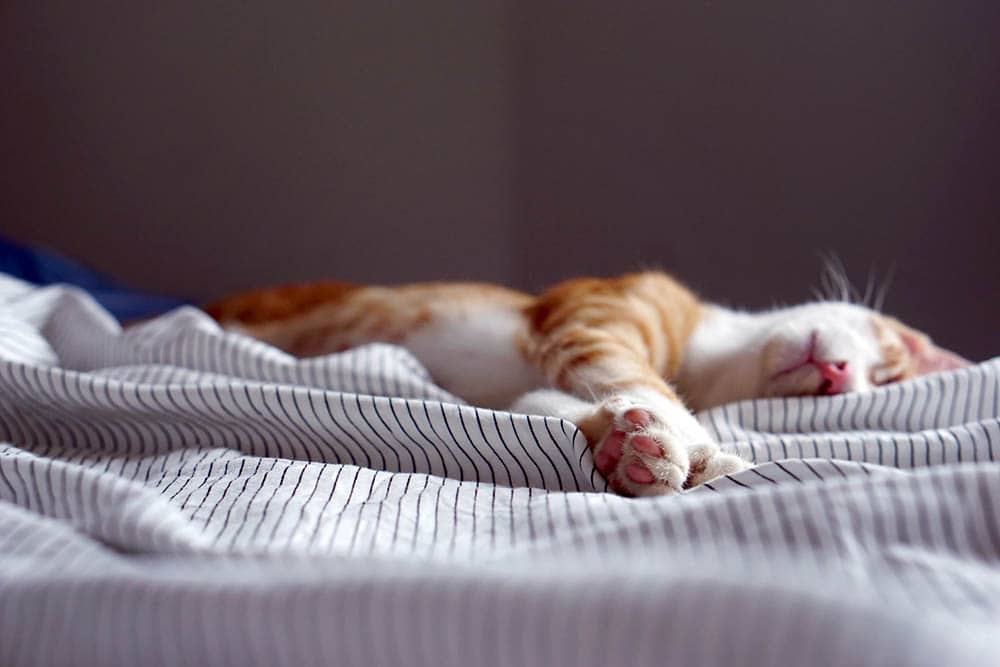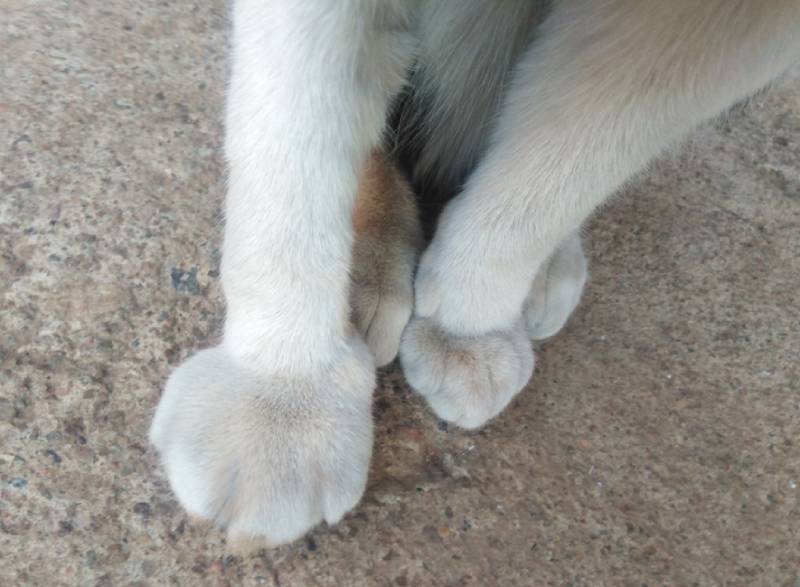17 Skinny Cat Breeds (With Pictures)

By Misty Layne
Updated on
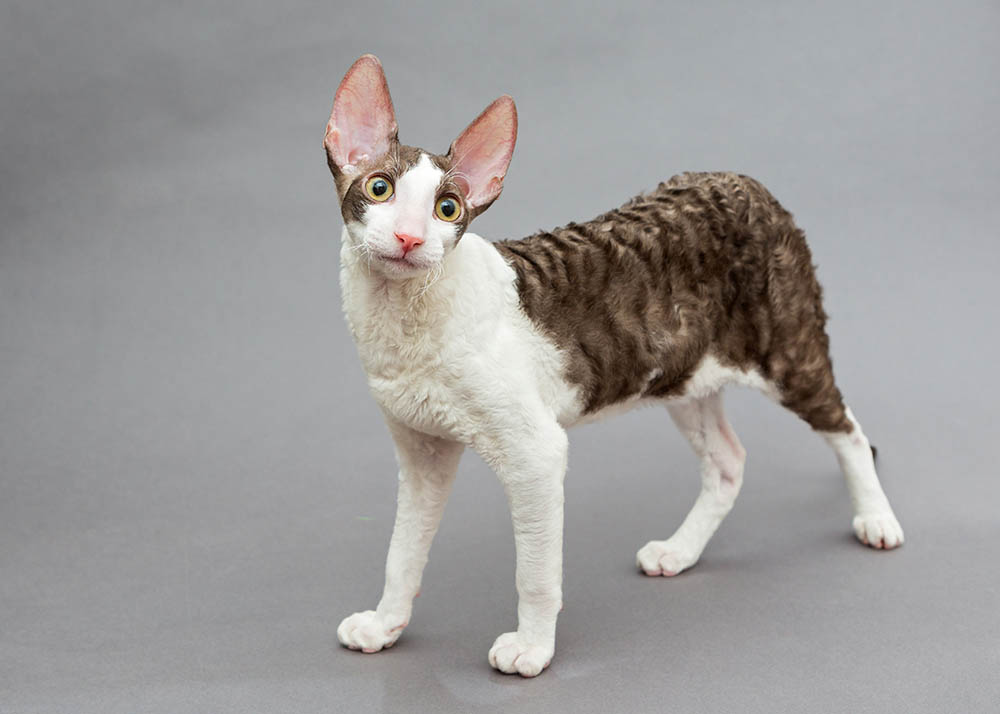
There is a plethora of cat breeds out there, which makes it a challenge to choose which kind of cat you want. How can you pick just one when they’re all so cute? However, if you know there are certain characteristics you’re looking for—such as a skinnier cat who’s on the smaller side—it helps to narrow down your search. And if a skinny cat breed is what you’re after, you’re in luck!
There are several skinny cat breeds you can choose from, such as one of these 17 breeds.
Top 17 Skinny Cat Breeds
1. Abyssinian Cat
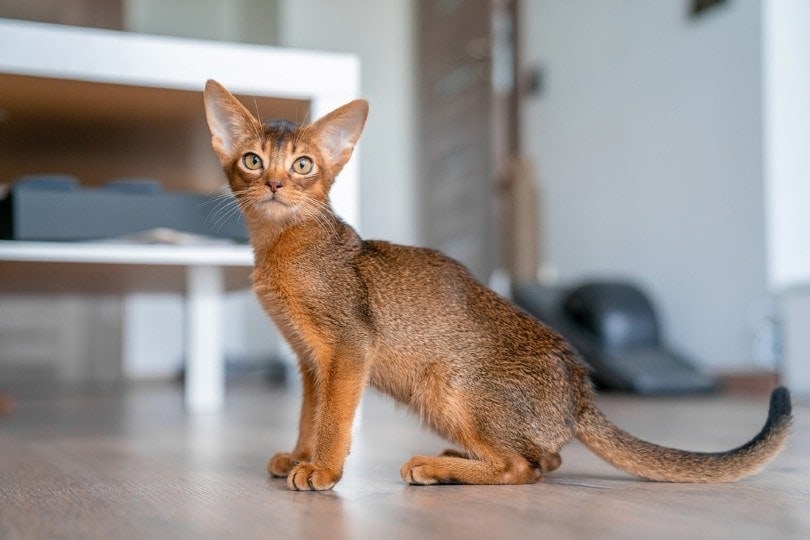
| Max weight: | 11–13 lbs |
| Traits: | Slender, thick tail, large ears |
Though likely one of the oldest cat breeds around, the first Abyssinian in the U.S. wasn’t bred till 1935. Also called The Aby, these skinny cats that resemble pumas are incredibly bright and highly active. They love to climb and explore and are fabulous at learning to do tricks. This breed is also an extremely happy one (they’re at their utmost happiness when they’re the only cat in the house). The Abyssinian can suffer from a hereditary condition known as pyruvate kinase deficiency, so that’s something to keep an eye on if you get this feline.
- Intelligent
- Playful
- Wants to be the only cat in the house
- May develop PK deficiency
2. Australian Mist
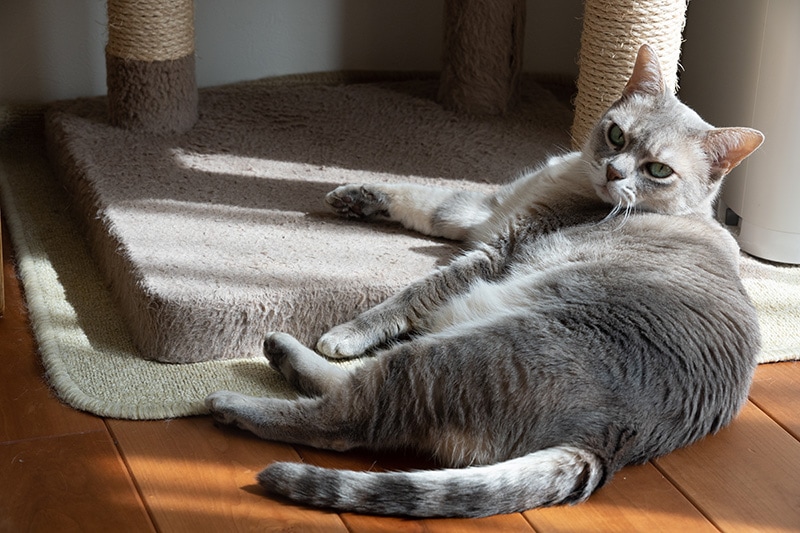
| Max weight: | 7–11 lbs |
| Traits: | Slender, thick tail, large eyes and ears |
This cat breed was created in Australia by mixing Australian Domestic shorthair cats, Burmese cats, and Abyssinian cats. While they may seem rather large as kittens, they only top out at 11 pounds when fully grown. Their coats are covered in specks, aka “mists”, and they come in a variety of colors, including dark grey, brown, and black. The Australian Mist is excellent for those living in apartments as it does well in smaller spaces. You’ll find that this cat is sweet, playful, and friendly. These cats are prone to gingivitis, so if you have one, you’ll need to stay on top of their dental health!
- Does well in smaller spaces
- Friendly
- More likely to develop gingivitis than other breeds
3. Burmese
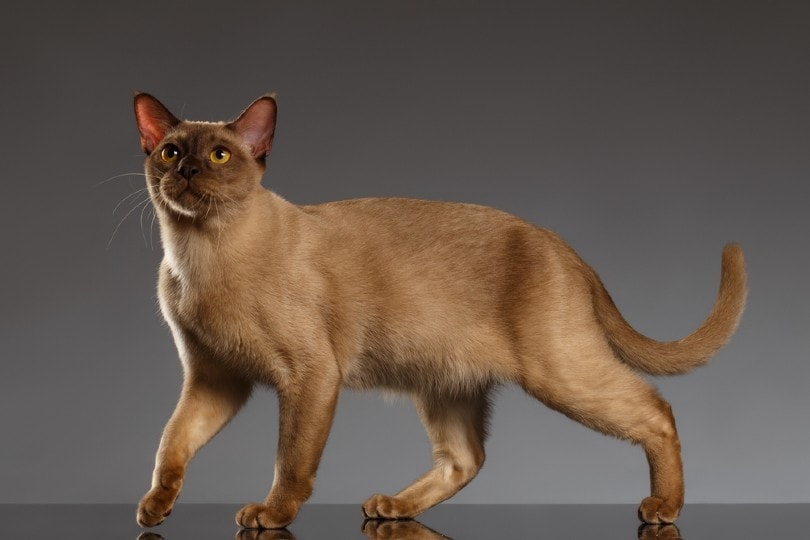
| Max weight: | 7–12 lbs |
| Traits: | Slender, thick tail, large ears, large round eyes, muscular |
Many people think the Burmese is a variation of the Siamese cat, but that’s incorrect. This was discovered in the 1930s when Dr. Joseph Thompson brought a Burmese cat back to the U.S. from Burma and tried to breed it with a Siamese. This cat breed doesn’t do well on its own, as it has a lot of energy and loves to play (you can even teach them to fetch!). They are brilliant, and you’ll find them to be quite stubborn, so prepare for some battles of wills. The Burmese is also known for overeating, so you’ll need to keep an eye on their diet to avoid excessive weight gain. This breed may also be prone to feline hyperaesthesia syndrome, which makes them sensitive to touch.
- Loves to play
- Intelligent
- Doesn’t do well on its own
- Stubborn
4. Chausie
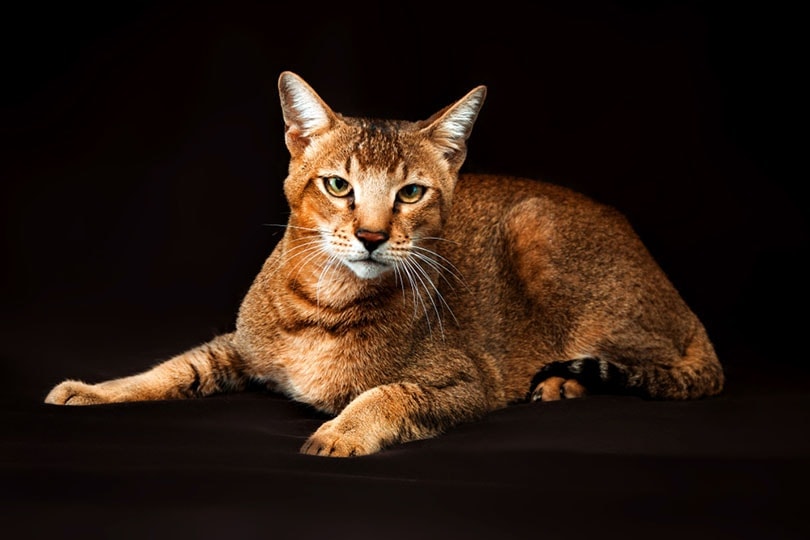
| Max weight: | 12–25 lbs |
| Traits: | Slender, thin tail, large ears, leggy |
It might surprise you that this cat breed is so slender, considering how much they can weigh. Blame it on the jungle cat genes! The Chausie was bred in Egypt from a mix of wild cats and domestic cats. Other traits they get from their wild ancestors are their highly active and restless natures. Because of that nature, this cat breed doesn’t do well in small spaces or when left on its own for long periods. And, though they are affectionate and loyal, they aren’t recommended for families with children. Chausies are wild and independent and incredibly daring, so you’ll need to keep an eye on this one! They’re also quite hardy and have no major health concerns.
- Loyal
- Intelligent
- Doesn’t do well on its own
- Not recommended for those with children or smaller spaces
5. Cornish Rex
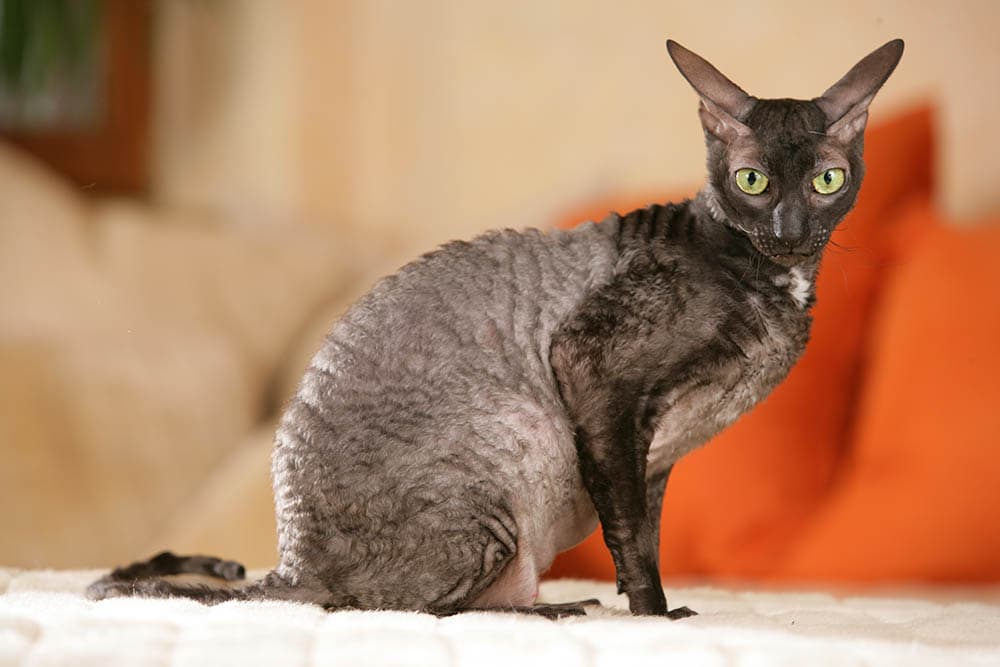
| Max weight: | 7–11 lbs |
| Traits: | Slender, thin tail, large ears, curly whiskers |
The Cornish Rex came about in 1950 due to a genetic mutation that resulted in its short, wavy coat. That coat is also how this breed gets its name, as it looks like a Rex rabbit. The Cornish Rex is sweet and attentive, as well as incredibly affectionate, making them a good fit for those with children or other animals. They are also extremely active and need plenty of attention, though, so you’ll need to dedicate lots of time to play. This breed doesn’t do well on its own for long periods because of its active nature, so they aren’t great fits for those who spend a lot of time away.
The Cornish Rex also isn’t well-suited to extreme temperatures, so they won’t do well as outdoor cats. This breed is generally healthy, but they are more predisposed to hypertrophic cardiomyopathy.
- Sweet
- Affectionate
- Doesn’t do well on its own
- Not great with extreme hot or cold temps
6. Devon Rex
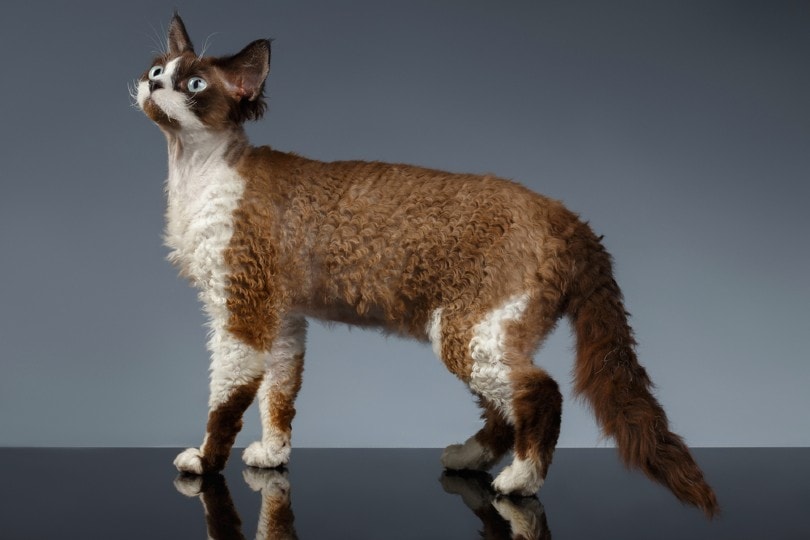
| Max weight: | 7–12 lbs |
| Traits: | Slender, thick tail, large ears, high cheekbones, long skinny necks |
The Devon Rex is often compared in looks to a pixie, and much like the pixies of folklore, these cats are mischievous! They are also incredibly social and highly affectionate, making them great pets for almost anyone (except those who are away from home a lot, as this breed can suffer from separation anxiety). The Devon Rex is also known to be a food hound; not only will they eat anything you give them, but they’re more than happy to nick some food from your plate as well! While generally healthy, this breed can develop hypertrophic cardiomyopathy and patellar luxation.
- Social
- Affectionate
- Doesn’t do well on its own
- Food thief
7. Japanese Bobtail
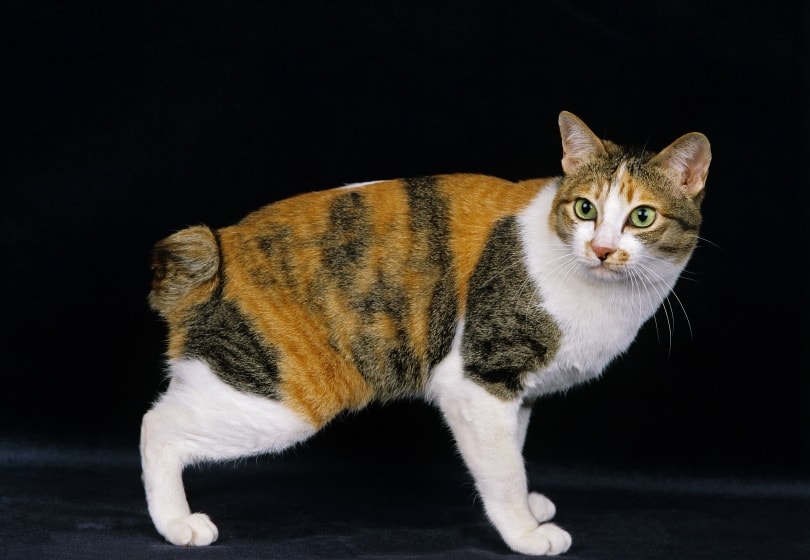
| Max weight: | 6–11 lbs |
| Traits: | Slender, short, kinked tail, tall ears |
The Japanese Bobtail originated in Japan and has an interesting tail that gives them their name—each cat’s tail is unique, but overall, all tails are short and kinked. These active, communicative cats are thought to bring good luck, and it’s easy to see why. They adore being around their people, love to play, and will take over your home if you let them! While they get along with other animals, when it comes to other cats, they much prefer the company of other Bobtails. This breed is also hardy with no predispositions to any major illnesses.
- Social
- Love to talk
- Thought to bring good luck
- Will take over the home
- Prefers other Bobtails when it comes to cats
8. Javanese
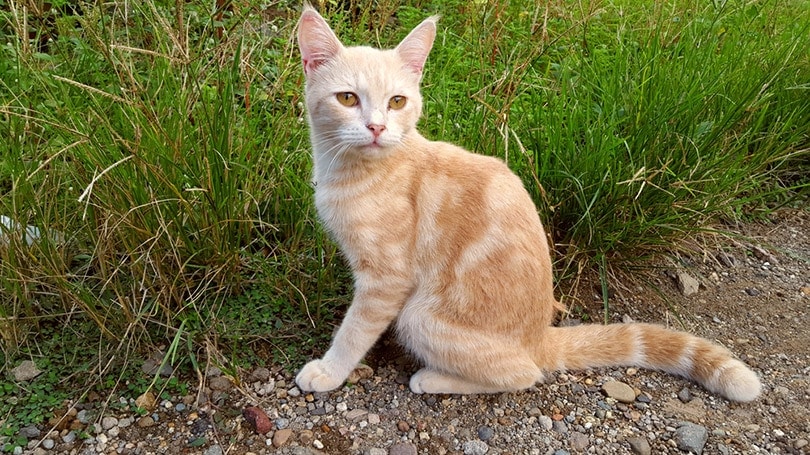
| Max weight: | 5–9 lbs |
| Traits: | Slender, thick, fluffy tail, large ears |
The Javanese is actually a version of a Colorpoint of the Siamese, developed from using Siamese, Balinese, and Colorpoint cats. Their name comes, not because they are native to Java, but because Java is close to Bali and Balinese are part of their ancestry. These tiny cats are people lovers who will follow your every move and try to “help” you with activities. Highly intelligent and active, this breed loves to learn tricks and play games. They do well in any size environment and love to receive attention.
The Javanese is also quite talkative! Because of their relation to the Siamese, this breed can be more prone to feline asthma and patellar luxation.
- Social
- Love to talk
- Always underfoot
9. Lykoi (Werewolf Cat)
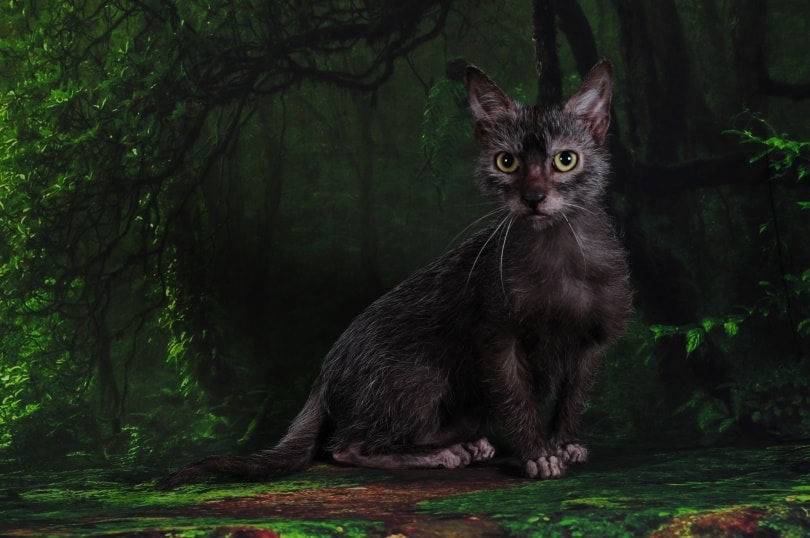
| Max weight: | 5–13 lbs |
| Traits: | Slender, hairless, large ears |
The Lykoi gets its name because it looks like a werewolf. This newer breed came about because of a natural genetic mutation and is primarily hairless (as in it has no undercoat and only patches of fur). How much hair a Lykoi will have varies from cat to cat. Because of their near hairlessness, this cat is strictly an indoor cat (do not, though, that it is not considered hypoallergenic). The Lykoi is relatively laidback and playful but also enjoys being independent. They have a high prey drive, so it’s best not to have small animals in the house along with them.
Thus far, no major diseases have been associated with this breed, though some may appear the longer they’re around.
- Laidback
- Playful
- Shouldn’t be around smaller animals
- Not a lap cat
10. Munchkin
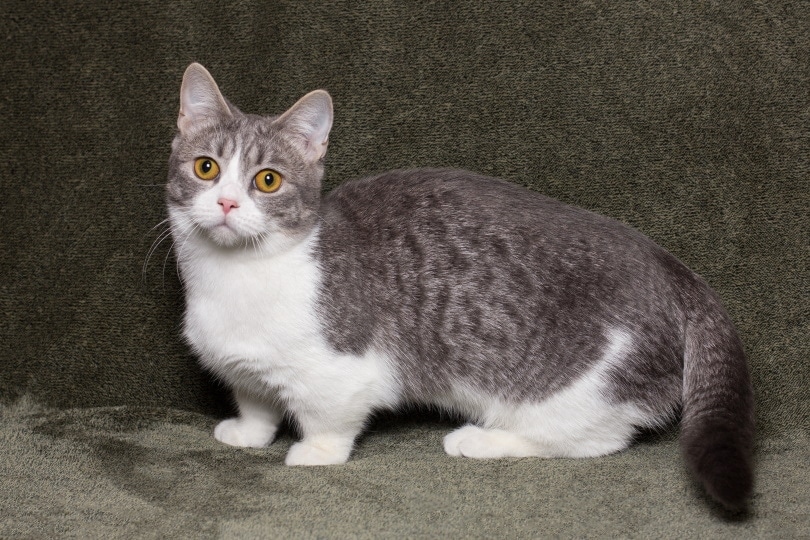
| Max weight: | 5–9 lbs |
| Traits: | Slender, thick tail, small ears |
This tiny, fluffy cat may be short in stature because of a mutation, but it doesn’t stop this breed from running, leaping, and playing. They will happily play and wrestle with other cats and dogs and love spending time with their humans. The Munchkin is incredibly bright and loves to explore. They’re also little thieves, affectionately called Magpies because they love shiny things that they will steal and hide. This is a younger breed, so thus far, no major illnesses have been associated with them.
- Sociable
- Playful
- Steals shiny objects
11. Oriental Shorthair
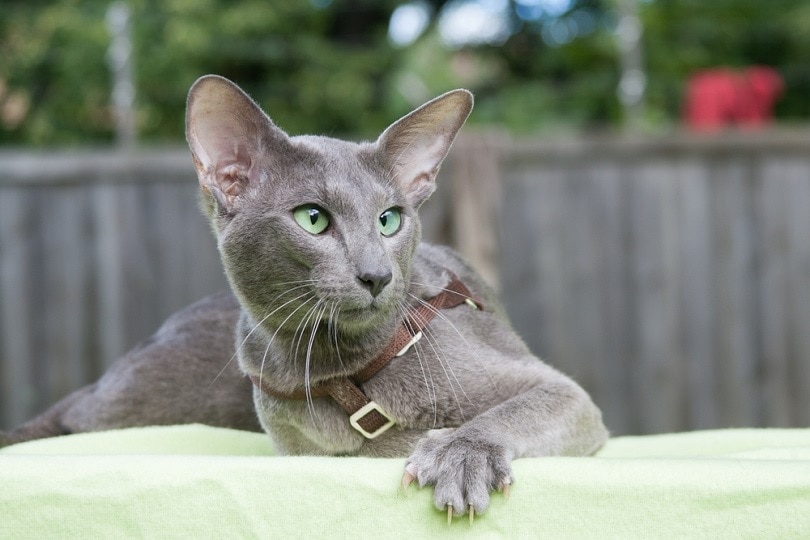
| Max weight: | 8–12 lbs |
| Traits: | Slender, thin tail, large ears, angular face |
The Oriental Shorthair was created by mixing Siamese, American, and British Shorthairs, Russian Blues, and Abyssinians to explore what colors and patterns could be made. Like the Siamese, the Oriental Shorthair is talkative, intelligent, and curious. These cats become quite attached to their humans (and don’t handle losing one very well at all). With this cat breed, you’ll find you have a tiny shadow everywhere you go. They do well in any type of living space, but they do require company—either yours or another pet.
When it comes to their health, they’ve inherited some diseases from their Siamese side, including hereditary liver amyloidosis and dilated cardiomyopathy.
- Smart
- Curious
- Highly attached to their people
- Doesn’t do well on their own
- Always underfoot
12. Peterbald
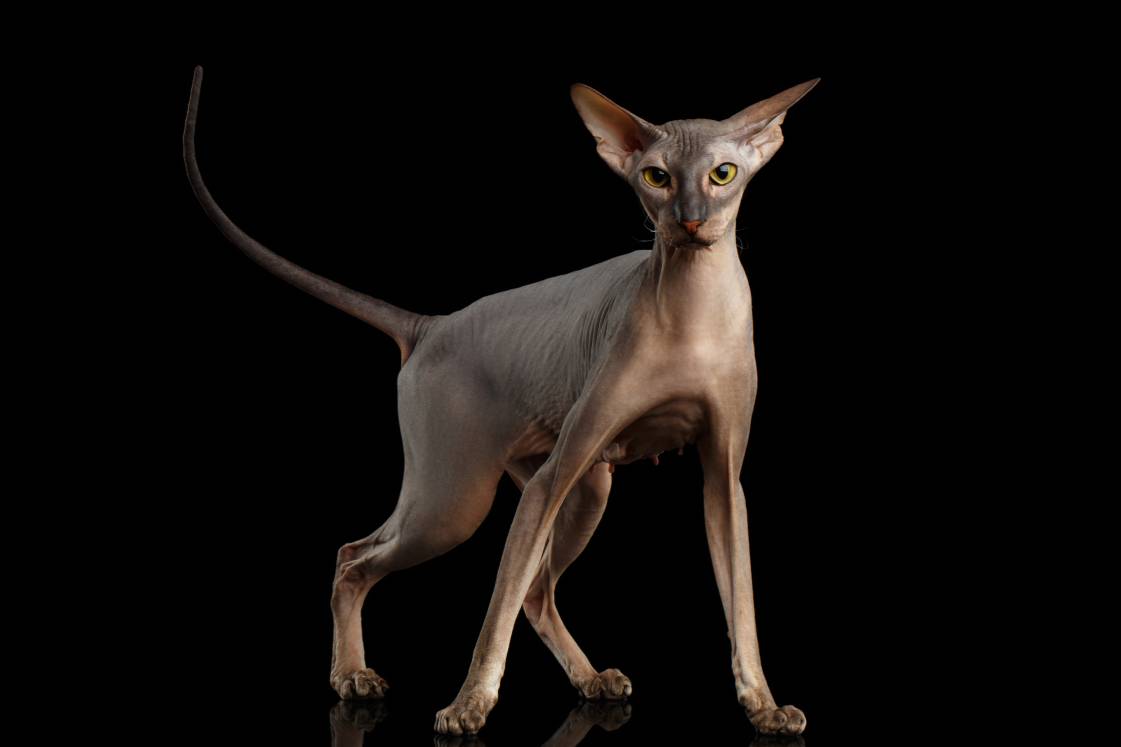
| Max weight: | 7-14 lbs |
| Traits: | Slender, hairless, large ears |
The Peterbald is another hairless cat (though, technically, it may have a coat that feels like peach fuzz rather than being entirely bald). Originating in Russia, this cat breed first appeared in 1988. Due to their lack of hair, they should be indoor cats rather than outdoor, as they can’t handle extreme cold or heat. These extroverts adore people and get along with other cats and even dogs. They’re quite calm and patient, so they make excellent pets for children. The Peterbald is known for “canine sensibilities ” as they will follow their humans around and even play similarly to dogs.
As of now, there are no significant health concerns known for the Peterbald.
- Calm
- Friendly
- Can’t be an outdoor cat
13. Russian Blue
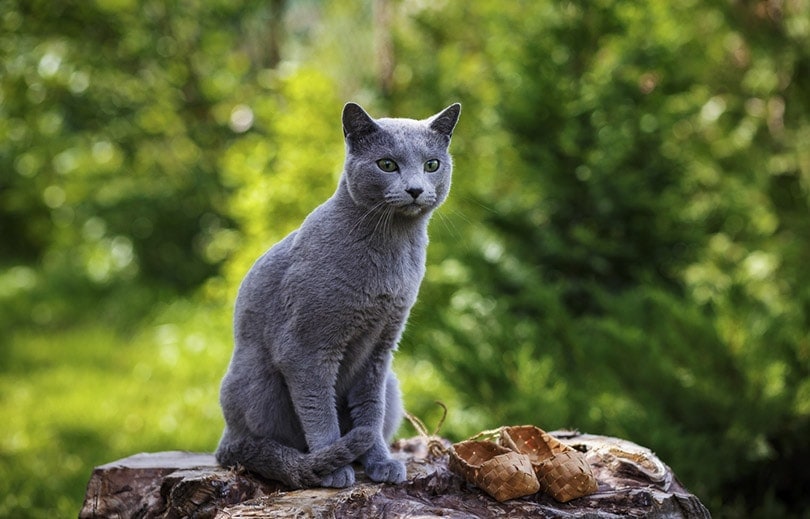
| Max weight: | 7–15 lbs |
| Traits: | Slender, thin tail, large ears, blue coat, green eyes |
This beautiful breed is known for its blue coat and green eyes. Not much is known about the Russian Blue’s origins, though. Some say they originated in the Archangel Isles; others say they are descendants of cats kept by Russian czars. Wherever they came from, you’re sure to fall in love with these gentle cats. Though wary of strangers, these reserved kitties love to play and show affection to their humans. This breed is very tolerant of children due to the cats’ extreme patience, but they do best with older children because they enjoy calm and peace. The same goes for other pets in the house.
The primary health concern with this breed will be obesity as they are quite fond of food!
- Calm
- Patient
- May not get along with younger children unless children are taught to handle them gently
14. Siamese
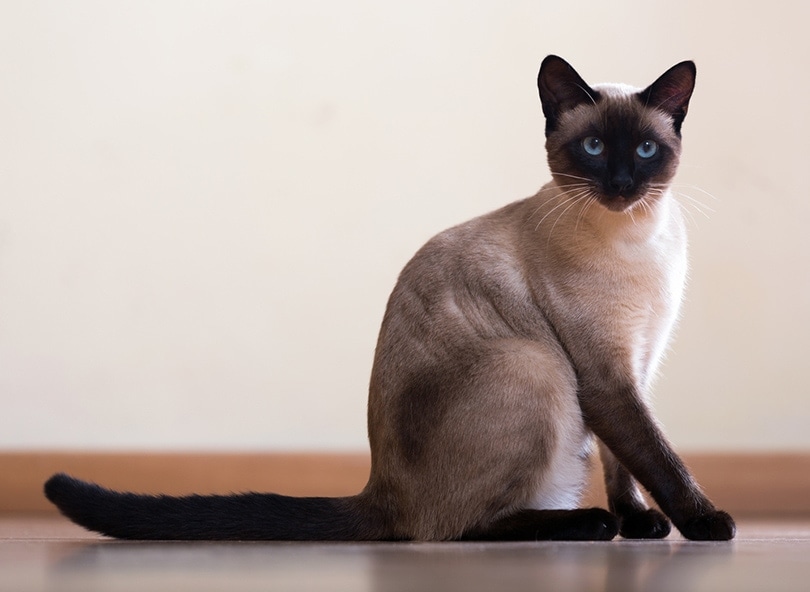
| Max weight: | 7–14 lbs |
| Traits: | Slender, thin tail, dark face, lighter body |
The Siamese cat is named after its birthplace, Siam (now known as Thailand), and is one of the oldest breeds out there. These cats are smart and curious and will get into absolutely everything as they explore. The Siamese will also become quite attached to their people and will follow you around so they can be involved in every aspect of your life. Though highly energetic and active, this breed also loves to cuddle and will crawl into your lap often.
Some Siamese may have issues with kinked tails or crossed eyes. Other than that, health concerns include bladder stones and eye disease.
- Loving
- Intelligent
- Cuddly
- Incredibly active
- Want lots of attention
15. Singapura
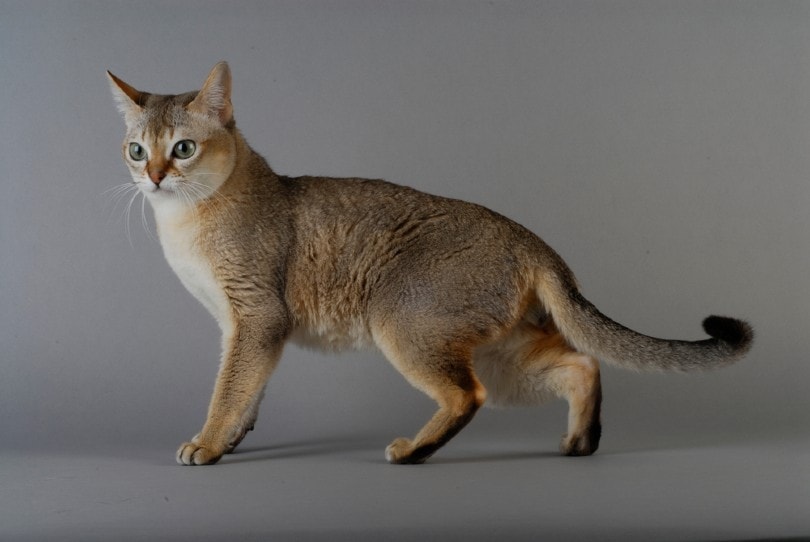
| Max weight: | 4–8 lbs |
| Traits: | Slender, thin tail, large ears and eyes, small feet |
Named after its birthplace of Singapore, the Singapura is known for being the smallest domestic cat. Though tiny, these cats are playful and curious (and sometimes called “pesky” because they are always underfoot as they help you go about your daily activities). They love to leap up high and engage in some play but are only moderately active overall. The Singapura is also exceptionally friendly to all, including other cats, dogs, and children. They are still relatively independent despite that friendliness, so this cat will make a good pet for those who work outside the home.
Though generally healthy, the smaller gene pool available to these cats may lead to problems down the road.
- Independent
- Curious
- Friendly
- ”Pesky”
16. Somali
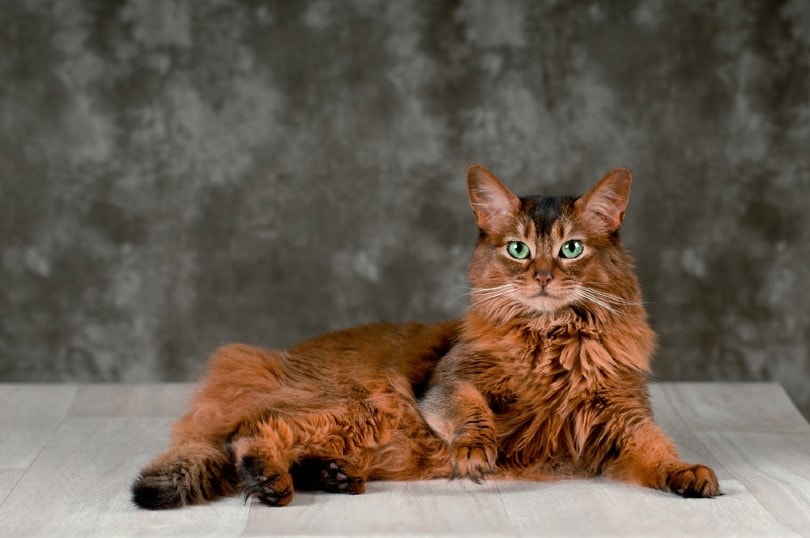
| Max weight: | 6–13 lbs |
| Traits: | Slender, thick tail, large ears, masked face, floofy |
The Somali isn’t a native of Somalia. Instead, they were given the name to match their sibling, the Abyssinian, as the Somali is thought to simply be a long-haired Abyssinian. These beauties are highly mischievous and known to be jokers. They love to play with people’s hair, whether it be the hair on their heads or the hair on their face. This breed is also incredibly active, highly intelligent, and needs lots of playtime and attention to avoid becoming bored. The Somali will do better in homes that always have someone around. They do well with older children but prefer to be the only animal in the house.
Some of the major health concerns these cats face are pyruvate kinase deficiency and renal amyloidosis.
- Jokesters
- Playful
- Need to have someone around
- Best for those without other pets
17. Turkish Angora
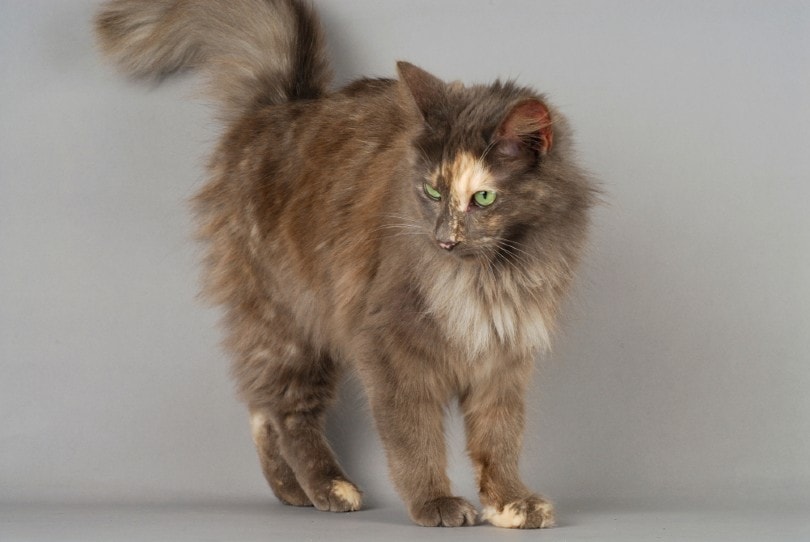
| Max weight: | 7–15 lbs |
| Traits: | Slender, thick tail, large ears |
The Turkish Angora has existed in Turkey since at least the 15th century but didn’t make it to the United States till the 1950s. Though you probably think of a white cat when you think of the Turkish Angora, in reality, they can come in a variety of colors and patterns. Though graceful and elegant, at heart, this breed is exceptionally outgoing, affectionate, and has a sense of humor. They’ll greet any guest that comes to your home and see them around. This breed is also intelligent and active, so you’ll find them getting into cabinets and playing with the water faucet. The Turkish Angora will love any home regardless of the age of the occupants and will get along with other animals (with the caveat that they are the ones in charge).
This breed is relatively healthy, though white Turkish Angoras with blue eyes are more prone to deafness. These cats may also be more susceptible to hypertrophic cardiomyopathy.
- Outgoing
- Affectionate
- Friendly
- King of the castle
- Will get into a lot
Conclusion
If a skinny cat is what you’re after, then you have plenty of skinny cat breeds from which to choose! Whether you want a cat full of fluff or one void of any hair, a cuddle bug, or an aloof beauty, you’ll surely find that one of these breeds satisfies your needs. Just be aware that a good majority of these breeds will be super active and will want to be heavily involved in everything you do. You’ll definitely want to be sure you’re ready to commit before adopting or buying!
See Also:
Featured Image Credit: Okssi, Shutterstock



